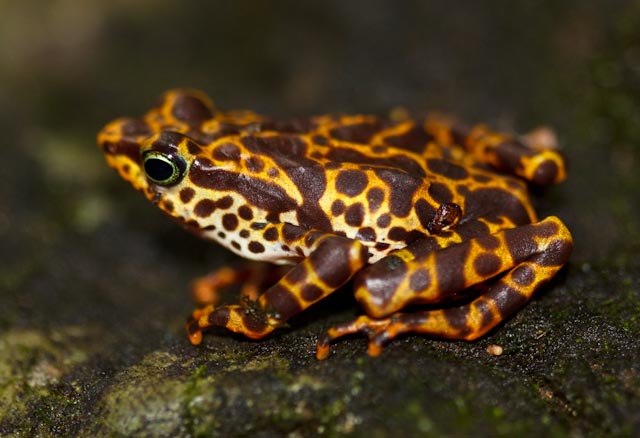Nuestro planeta alberga casi 9.000 especies de anfibios. Durante más de 100 años, estos animales han sufrido dramáticamente las consecuencias de la deforestación, la agricultura, el drenaje de humedales, los productos agroquímicos y otros contaminantes. En los últimos tiempos han surgido nuevas amenazas que hacen que el 40% de todas las especies de anfibios estén en riesgo de extinción según la “Lista Roja” de la Unión Internacional para la Conservación de la Naturaleza (UICN), recientemente actualizada. Entre las nuevas amenazas figuran el cambio climático y las enfermedades infecciosas emergentes. Entre ellas, los hongos quitridios de los anfibios que desempeñan un papel fundamental. Estos hongos han sido diseminados por todo el mundo por los seres humanos y producen la enfermedad quitridiomicosis cutánea en los anfibios, que ocasiona descensos de poblaciones e incluso extinciones.
Hace ya 30 años que investigadores, conservacionistas y otras partes interesadas se dieron cuenta de la crisis que atraviesan los anfibios. Se han puesto en marcha varias iniciativas a escala mundial, regional y local para salvaguardar la diversidad de los anfibios, incluidos numerosos planes de gestión y acción. Gracias a estas actividades, hemos aumentado enormemente nuestros conocimientos sobre dónde se produce el declive, así como los mecanismos que lo explican y cómo interactúan las amenazas. Esto va de la mano de un enorme compromiso con la protección de los hábitats naturales sumado a la cría en cautividad en instalaciones para la conservación. También se conocen mucho mejor las enfermedades y sus agentes. Ha habido muchas historias de éxito y sin toda la inversión, el trabajo y la pasión de actores involucrados muchas especies de anfibios ya se habrían extinguido.
Sin embargo, es difícil apreciar en qué punto nos encontramos para superar la crisis de los anfibios. Las amenazas y la vulnerabilidad hacia ellas no es igual para todas las especies. Algunos anfibios son más susceptibles y sufren más las consecuencias de las amenazas. Representan los «peores escenarios» de la crisis de los anfibios. De muchos de ellos carecemos de información suficiente para conocer su estado actual. No es el caso de los sapos arlequín, género Atelopus, de América Central y del Sur, que aun con la información que tenemos continúan en alto riesgo. Se trata de animales pequeños, a menudo coloridos y de actividad diurna, que habitan desde selvas tropicales de tierras bajas hasta los páramos andinos por encima del límite arbóreo.
Se conocen más de 130 especies de Atelopus y, al ser muy sensibles a las amenazas, muchas de esas especies han disminuido e incluso se teme que se hayan extinguido. Los sapos arlequín son el ejemplo más representativo de la crisis de los anfibios y, los científicos han estudiado los datos sobre el estado de sus poblaciones desde principios de los años noventa, debido a su aspecto icónico. En un estudio reciente publicado en Communications Earth and Environment, Lötters y 99 colegas, en su mayoría conservacionistas e investigadores de países donde los sapos arlequín se dan de forma natural, compararon los datos sobre el estado de las poblaciones en 2004 y 2022 para examinar las tendencias específicas de las especies en las dos últimas décadas.
Los datos de los autores confirman que los enormes esfuerzos de conservación de muchos científicos, conservacionistas y comunidades locales han revelado que más de 30 especies de Atelopus que en parte se temía que hubieran desaparecido, ¡todavía están ahí! Sin embargo, las pruebas sugieren que, al mismo tiempo, todas las especies siguen amenazadas y su estado de conservación no ha mejorado. Los factores que amenazan a los sapos arlequines que aún sobreviven siguen siendo los mismos e incluyen el cambio de hábitat y la propagación del hongo quitridio. Además, los autores demostraron que en el futuro los sapos arlequines sufrirán las consecuencias del cambio climático.
Los autores concluyen que otros anfibios que se encuentran en la peor situación siguen en peligro, lo que demuestra que la crisis de los anfibios sigue siendo una emergencia. Gracias al enorme esfuerzo puesto en la conservación, por redes de colaboración como la recientemente lanzada Atelopus Survival Initiative bajo el paraguas del Atelopus Task Force del Amphibian Specialist Group de la UICN, estos anfibios aún no han desaparecido. Ahora más que nunca es fundamental continuar e incrementar los esfuerzos para salir de la emergencia que sigue siendo la crisis de los anfibios.
Lötters, S., A. Plewnia, A. Catenazzi, K. Neam, A.R. Acosta-Galvis, Y. Alarcon Vela, J.P. Allen, J.O. Alfaro Segundo, A. de Lourdes Almendáriz Cabezas, G. Alvarado Barboza, K.R. Alves-Silva, M. Anganoy-Criollo, E. Arbeláez Ortiz, J.D. Arpi L., A. Arteaga, O. Ballestas, D. Barrera Moscoso, J.D. Barros-Castañeda, A. Batista, M.H. Bernal, E. Betancourt, Y.O. da Cunha Bitar, P. Böning, L. Bravo-Valencia, J.F. Cáceres Andrade, D. Cadenas, J.C. Chaparro Auza, G.A. Chaves-Portilla, G. Chávez, L.A. Coloma, C.F. Cortez-Fernandez, E.A. Courtois, J. Culebras, I. De la Riva, V. Diaz, L.C. Elizondo Lara, R. Ernst, S.V. Flechas, T. Foch, A. Fouquet, C.Z. García Méndez, J. E. García-Pérez, D.A. Gómez-Hoyos, S.C. Gomides, J. Guerrel, B. Gratwicke, J.M. Guayasamin, E. Griffith, V. Herrera-Alva, R. Ibáñez, C.I. Idrovo, A. Jiménez Monge, R.F. Jorge, A. Jung, B. Klocke, M. Lampo, E. Lehr, C.H.R. Lewis, E.D. Lindquist, Y.R. López-Perilla, G. Mazepa, G.F. Medina-Rangel, A. Merino Viteri, K. Mulder, M. Pacheco-Suarez, A. Pereira-Muñoz, J.L. Pérez-González, M.A. Pinto Erazo, A.G. Pisso Florez, M. Ponce, V. Poole, A.B. Quezada Riera, A.J. Quiroz, M. Quiroz-Espinoza, A. Ramírez Guerra, J.P. Ramírez, S. Reichle, H. Reizine, M. Rivera-Correa, B. Roca-Rey Ross, A. Rocha-Usuga, M.T. Rodrigues, S. Rojas Montaño, D.C. Rößler, L.A. Rueda Solano, C. Señaris, A. Shepack, F.R. Siavichay Pesántez, A. Sorokin, A. Terán-Valdez, G. Torres-Ccasani, P.C. Tovar-Siso, L.M. Valencia, D.A. Velásquez-Trujillo, M. Veith, P.J. Venegas, J. Villalba-Fuentes, R. von May, J.F. Webster Bernal & E. La Marca (2023): Ongoing harlequin toad declines suggest the amphibian extinction crisis is still an emergency. — Communications Earth and Environment, 4, 412. https://www.nature.com/articles/s43247-023-01069-w

